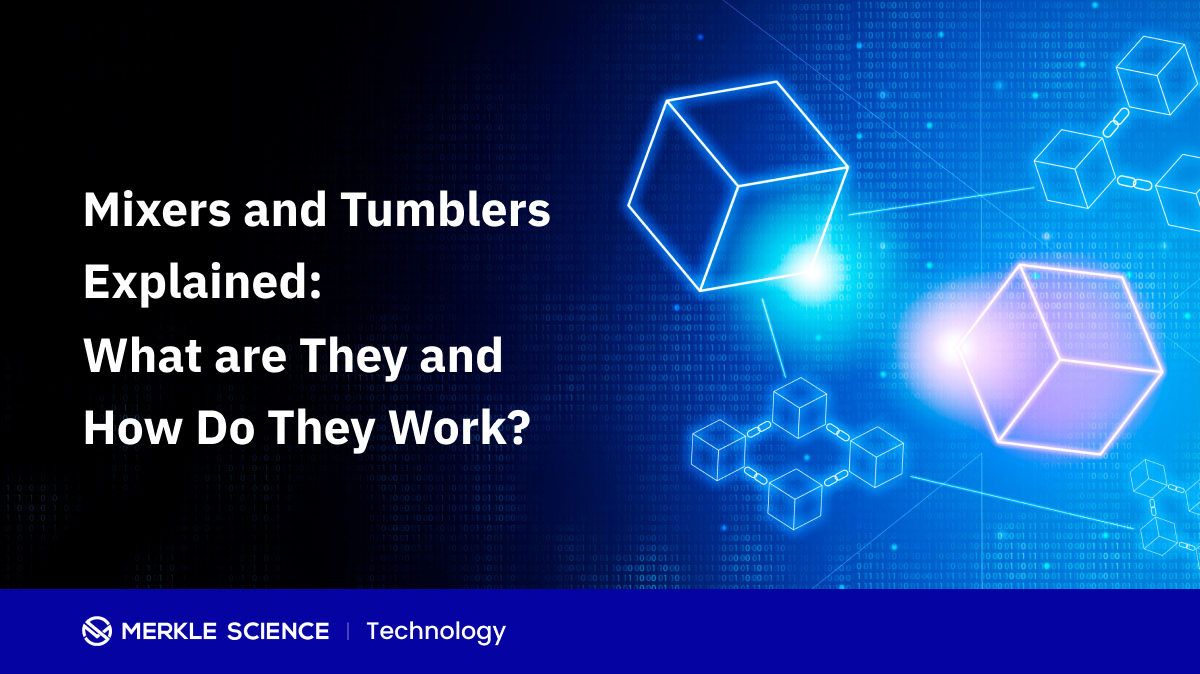Mixers and Tumblers Primer: Overview, Types, Pros and Cons, Legal Status and How They Work

Merkle Science

The common narrative surrounding the anonymity of crypto transactions is not entirely true, in truth activities on the blockchain, especially public blockchains like Bitcoin and Ethereum are more pseudonymous.
Though it is true, that in crypto transactions, the transacting parties can transact between themselves without revealing their identities and involving intermediaries, this isn’t true anonymity. These transactions are visible and accessible on the public blockchain. Third parties, such as blockchain analytics companies can easily trace these transactions and identify the attached crypto wallet addresses. While it is true that transaction data may not reveal the real-world identity of an entity; however, the associated wallet addresses can provide clues to an entity’s actual identity. Therefore, transacting parties risk having their data revealed and their account transaction logs traced back to them. Mixers and tumblers seek to help solve this issue by providing complete anonymity and preserving user privacy.
With the increasing use of mixers and tumblers in various illicit activities such as money laundering and hacks, the regulatory scrutiny over mixers&tumblers is increasing. For example on October 6, 2021, the U.S. Department of Justice announced the National Cryptocurrency Enforcement Team (NCET), an enforcement team dedicated to investigating and prosecuting criminal misuses of cryptocurrency — in particular mixers& tumblers.
What are mixers and tumblers and what are the different types?
Mixers and tumblers are cryptographic facilities or services that mix different streams of potentially traceable crypto funds concealing the trail leading back to the fund’s original source. Essentially, crypto owners use mixing&tumbling services to mix their coins with others to maintain privacy.
There are two categories of mixers, centralized and decentralized mixers. The primary difference between the two is that the centralized mixers are owned and controlled by third parties whereas decentralized mixers are not.
When using centralized mixers&tumblers, crypto owners leverage the services of a third party to mixer their coins and keep them anonymous. The biggest pitfall of using centralized mixers is that they can keep access to the users’ logs and IP addresses. Further, since these platforms might not be registered with any of the regulators, they can disappear with users’ funds without any trace.
Decentralized mixers provide peer-to-peer mixing services, where users mix their coins themselves. Crypto holders band together and pool their coins to make one significant transaction, and the coins then get randomly returned to the pool members. The higher the number of users in the pool, the higher the randomization. For instance, CoinJoin, which is one of the most popular decentralized mixers, improves the privacy of its users by coordinating inputs of multiple users into a single transaction. This transaction gets broken into multiple outputs obscuring the origin of crypto.
Pros &cons of using mixers and tumblers
Pros:
- Mixers and tumblers offer anonymity to the users by breaking the link between users’ transaction logs and their identities, thereby enhancing user privacy. Lack of anonymity makes crypto users susceptible to data breaches and leaks, for example, some exchanges collect and share the data of their users without their consent in order to develop transaction trackers. Additionally, some governments also collect information and statistics related to the ownership and transfer of crypto assets.
- Further, crypto holders also use mixers and tumblers to protect themselves from hacks and scams. Mixers and tumblers employ a foolproof algorithm to ensure that their users’ coins do not get stolen on redirected to phishing sites.
- They make it more difficult (but not impossible) for third-party organizations like blockchain analytics firms to track users' funds.
Cons:
- While encryption and anonymity are essential in certain situations, the tumbling process may also be used by bad actors in an attempt to make their proceeds from hacking, drug trafficking, ransomware attacks and such appear legitimate.
- Mixers and tumblers can be used for illegal activities such as money laundering because it obfuscates the source of funds and makes it easier for the bad actors to stay anonymous.
- There’s also no way to ensure the safety of funds sent to mixers. Third-party mixers and tumblers give rise to the risk of theft. In order to access the service, a user has to send its crypto to the service provider. There is a chance that the service provider may not return the clean coins as expected
- Third parties like blockchain analytics companies may trace users’ transactions. Since coin mixers use patterns to mix crypto, once this pattern is discovered, operations can be analyzed, and transactions can be traced.
How do mixers & tumblers work?
Coin mixers usually work based on certain algorithms. These algorithms follow a simple process wherein a user sends their crypto to a mixer’s address, which is registered for each user individually. The coins are then mixed with transactions of other people or distributed among hundreds of thousands of wallets that belong to a mixer. In order to further obscure the identity of the user, the mixer may repeat this process a number of times. Once the process is completed, "clean" bitcoins are transferred to the pre-determined address—either back to the sender or the new owner.
How Can Merkle Science Help?
To mitigate the risks mixers and tumblers pose to users, investors, and the financial system, the regulatory oversight over them is increasing. In order to protect themselves from exposure to the AML/CFT risks, crypto businesses should proactively put compliance frameworks in place to monitor all transactions surrounding stablecoins and to mitigate AML/CFT risks.
Merkle Science provides a predictive crypto risk and intelligence platform, setting the standard for the next generation of financial safeguards and criminal detection. We are creating the infrastructure necessary so that a full range of individuals, entities, and services may transact safely with crypto. Merkle Science’s highly customizable platform and proprietary Behavioral Rule Engine is easy-to-use, allowing institutions to detect illicit activity beyond the blacklists and detect suspicious activity that could have previously been undetected.


